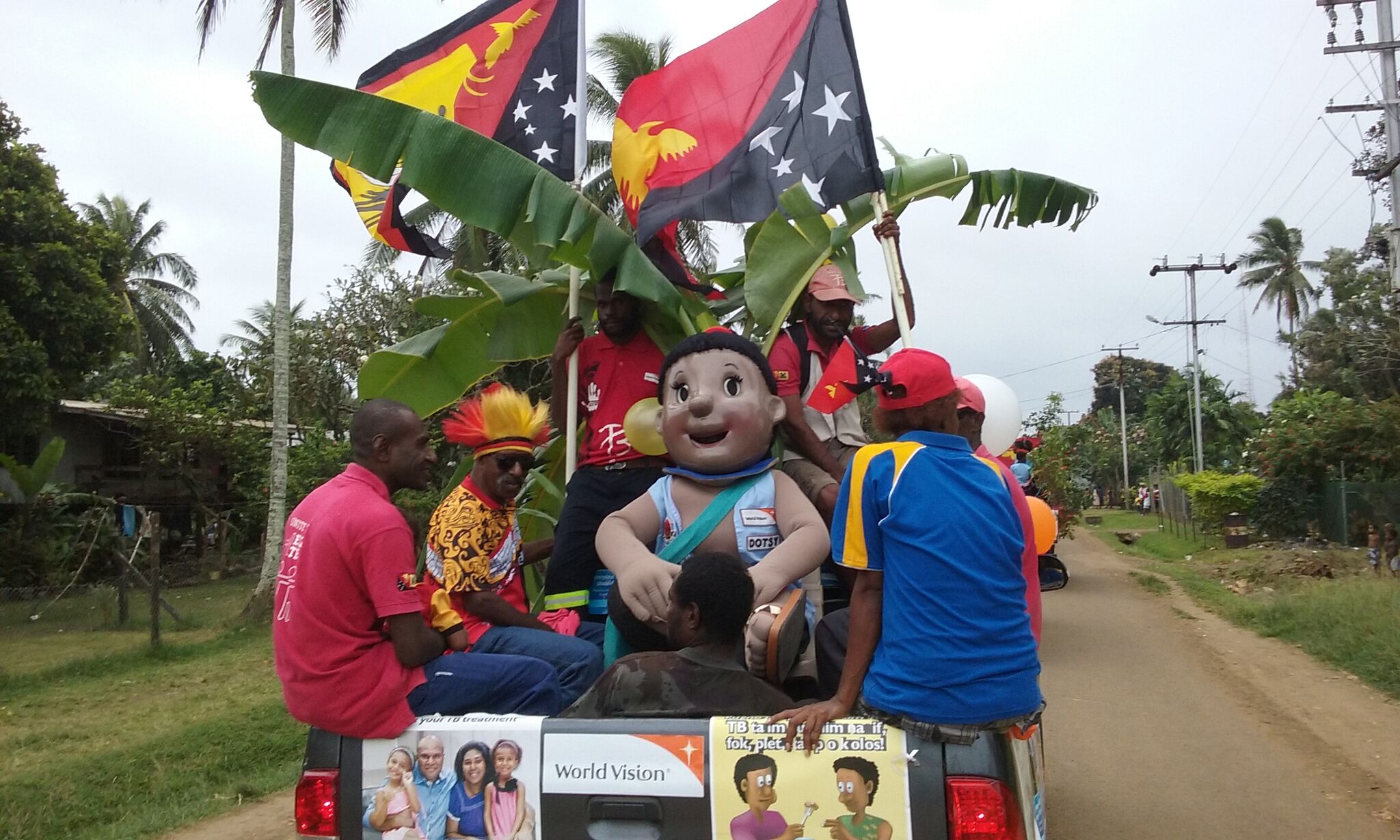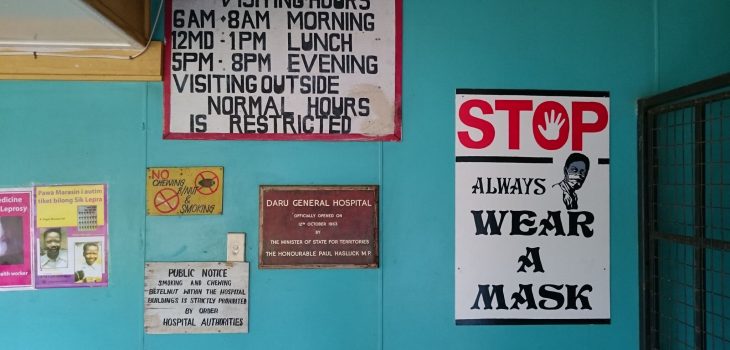By Jeremy Hill (London School of Hygiene & Tropical Medicine)
World tuberculosis (TB) day is a valuable opportunity to focus on the global epidemic of tuberculosis. In London, I’ll be attending a symposium hosted by LSHTM and UCL where the program includes the breadth of topics: from the natural history of TB, through to strategies for its elimination. While I’m there I will also be thinking of TB Day last year, which I spent in a very different setting; Daru, the capital of Papua New Guinea’s Western Province and my home for most of 2015 and 2016. My role there was as a doctor at Daru General Hospital; primarily, I was looking after patients affected by a severe epidemic of tuberculosis. Aside from the large number of people affected, the epidemic in Daru is made all the more challenging by high rates of drug resistant TB, including the most difficult to treat infectious strains, multi-drug resistant and extensively-drug resistant TB (MDR- and XDR-TB). Being a small town of 16,500 people in a remote and under-served part of the world, this slow-burn humanitarian crisis is not very well known, especially in comparison to the much larger scale of the epidemic in more populous parts of the world. However the intensity of the problem, the devastating impact on people and their communities, and the committed response of program leaders and their teams on the ground are all good reasons for members of the health policy community to pay attention.
Context
 Let’s start with some context. Daru is an island, 5km across, located just off the southern coast of Western Province. To the south, across the narrow Torres Strait, is the Australian state of Queensland, to the east is the mouth of the Fly River (Papua New Guinea’s longest), and to the West is the protected coastline and the border with Indonesia’s West Papua. The mainland to the north is a remote, sparsely populated region of swamps, forest and waterways – people coming from villages in the South and Middle Fly Districts often travel for days by foot, vehicle and canoe to access essential services in Daru. Responding to droughts, resource limitation affecting regional services, and degradation of the Fly River by the Ok Tedi mine in its headwaters, many displaced people have stayed in Daru to form overcrowded waterfront settlements. This combination of displaced and transitory populations, resource limitation, food insecurity and health seeking across international borders sets the scene for amplified TB transmission and for big challenges to the continuity of TB care.
Let’s start with some context. Daru is an island, 5km across, located just off the southern coast of Western Province. To the south, across the narrow Torres Strait, is the Australian state of Queensland, to the east is the mouth of the Fly River (Papua New Guinea’s longest), and to the West is the protected coastline and the border with Indonesia’s West Papua. The mainland to the north is a remote, sparsely populated region of swamps, forest and waterways – people coming from villages in the South and Middle Fly Districts often travel for days by foot, vehicle and canoe to access essential services in Daru. Responding to droughts, resource limitation affecting regional services, and degradation of the Fly River by the Ok Tedi mine in its headwaters, many displaced people have stayed in Daru to form overcrowded waterfront settlements. This combination of displaced and transitory populations, resource limitation, food insecurity and health seeking across international borders sets the scene for amplified TB transmission and for big challenges to the continuity of TB care.
Papua New Guinea is included on on all three high-burden lists published by the WHO (overall burden, and separate lists for DR-TB and TB/HIV coinfection), with an overall case notification rate in 2015 of 368 per 100,000. However, the TB epidemic in Daru is much more intense: in 2015 we diagnosed 120 people with DR-TB, yielding a local case notification rate of more than 700 per 100,000 for DR-TB alone. For all forms of TB, the notification rate was around 3000 – compare this to the rate of 6 per 100,000 just a few kilometres south in Australia. The burden of disease in Daru is extraordinary, and the impact on the community was profound. Remembering that DR-TB treatment involves at least 20 months of daily observed medicines, with 8 months of daily injections, imagine the prominent place that DR-TB treatment of 120 new patients each year would have in a small town. Imagine schoolchildren excusing themselves from class once a day, or adults managing this around work, or the hundreds of people contributing to the implementation of this sort of treatment program. Imagine a similar program of IV chemotherapy if it were a large cluster of cancer cases in a similar low resource setting. I’m still blown away by the resilience and ingenuity of staff and patients in Daru – and with this in mind I will highlight a few personal observations.
- Patients are almost always resilient and committed to their treatment, even those who are missing it
While working as a doctor in Daru, I encountered the convenient attitude of blaming drug-resistance on patients who don’t take their treatment. I encountered this amongst, p atients, leaders, nurses, doctors and myself. In contrast with this perception, patients who missed treatment usually had genuine, understandable reasons for doing so – sometimes a consequence of the treatment regimen itself. Reviewing our program data for weekly treatment adherence conclusively put this to rest: adherence to treatment remained higher than 90% regardless of the resources or staff available. Further, we could pick out the groups of patients who were vulnerable to missed treatment. Families dependent on subsistence fishing or farming, for example, would occasionally miss treatment to obtain food. This emphasised to me the common sense approach of improving adherence by identifying and helping patients deal with the day to day difficulties that TB treatment causes.
atients, leaders, nurses, doctors and myself. In contrast with this perception, patients who missed treatment usually had genuine, understandable reasons for doing so – sometimes a consequence of the treatment regimen itself. Reviewing our program data for weekly treatment adherence conclusively put this to rest: adherence to treatment remained higher than 90% regardless of the resources or staff available. Further, we could pick out the groups of patients who were vulnerable to missed treatment. Families dependent on subsistence fishing or farming, for example, would occasionally miss treatment to obtain food. This emphasised to me the common sense approach of improving adherence by identifying and helping patients deal with the day to day difficulties that TB treatment causes.
- Innovations and policy changes at a global level can directly and immediately affect programmatic management
Although Daru is remote and inaccessible, the peer reviewed findings, recommendations, guidelines agreed and published by multilateral organisations or journals such as Health Policy and Planning are not. In addition to this, the TB epidemic in Daru is exceptional – TB is the leading cause of death in Papua New Guinea, and with transmission of DS-, MDR- and XDR-TB occurring in the community, new tools and innovations can and should be rapidly implemented with commensurate monitoring and support. Health policy actors should orient their work to make it accessible to decision makers in high-burden settings; efforts to do so are welcome and already having an effect.
- Multiple partner organisations collaborated to deliver a high-quality DR-TB treatment program despite limited resources
By collaborating, working towards shared goals, and adapting where necessary, Daru General Hospital and the Western Province Health Office worked with partners World Vision, the Burnet Institute and HHISP to rapidly improve the DR-TB program in short order. By drawing on the expertise of multiple different partners to deliver basic outcomes, the program built trust with the Daru community, National TB Program, funders from the Australian Department of Foreign Affairs and Trade and multilateral organisations. Starting with infection control and triage at the hospital, and ending with community based treatment and implementation of new TB drugs, leaders at these organisations demonstrated that many aspects of programmatic management of DR-TB are low-tech but administratively complex, and can be done well with limited resources.
Conclusion
Despite the improvement in the curative program, the epidemic is undiminished – of course, treating patients as they arrive at the hospital will not put a dent in that. In response, program leaders are planning a systematic screening initiative, a dramatic intervention that will require support at all levels, including multilateral TB policies and peer-reviewed publications. So, wherever you are on the 24th, remember that our discussions, publications, tweets and actions in this field should be oriented towards the patients and communities affected by TB. Know that patients are committed, know that people want treatment, and remember that policies to support scale up of case finding, diagnosis, treatment and prevention should respond to that – this is true of the largest scale epidemics, the smaller but focused burden in Daru, and everything in between.
—
Look out for our #WorldTBDay special online collection and further blog and podcast from Dr Mishal Khan on Friday 24th March!











